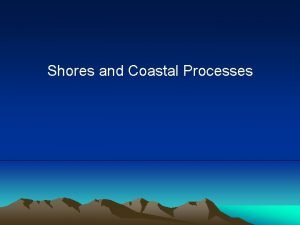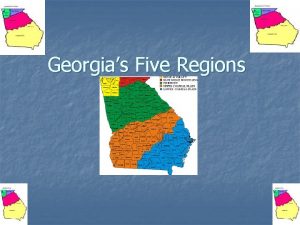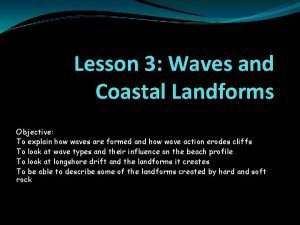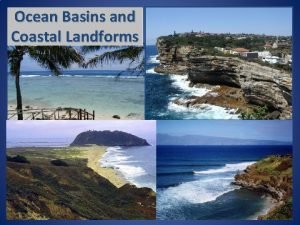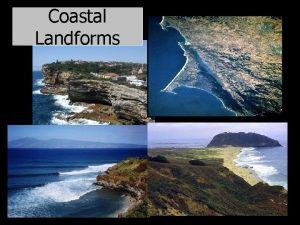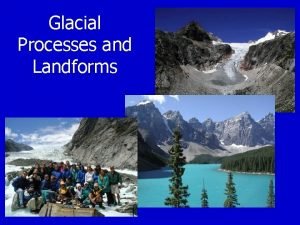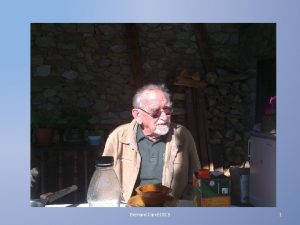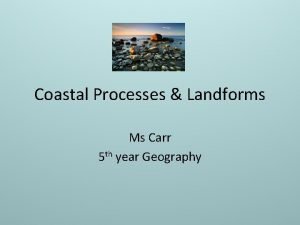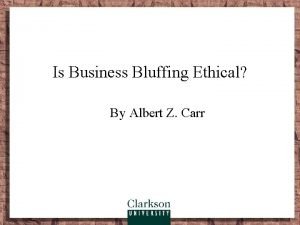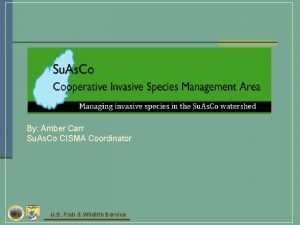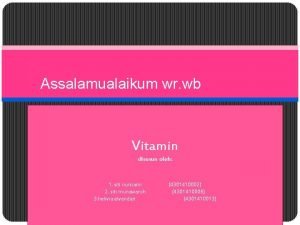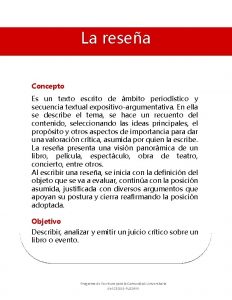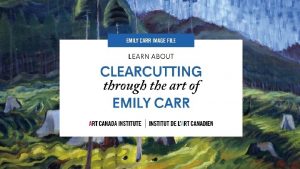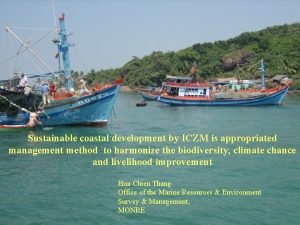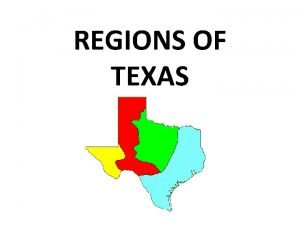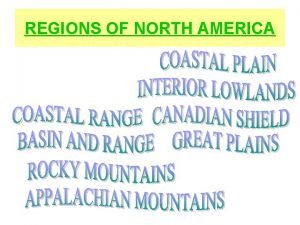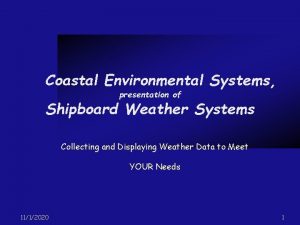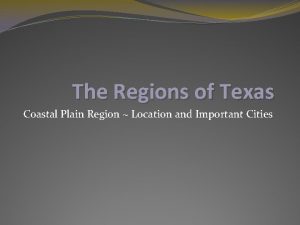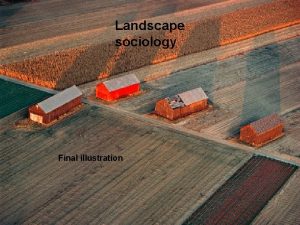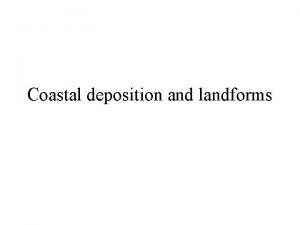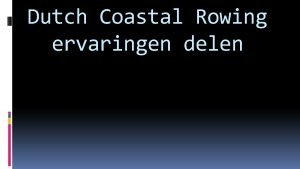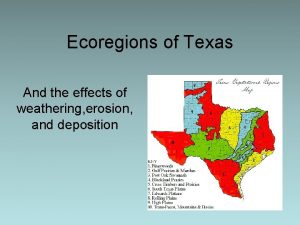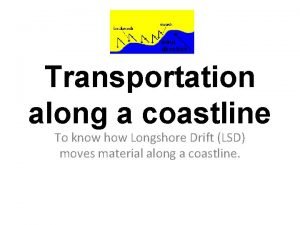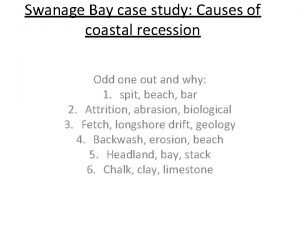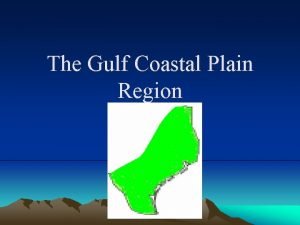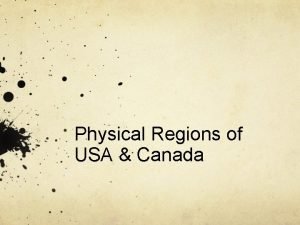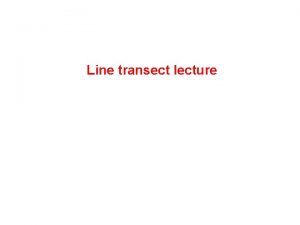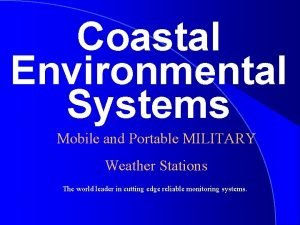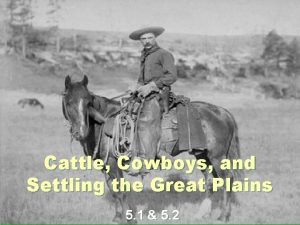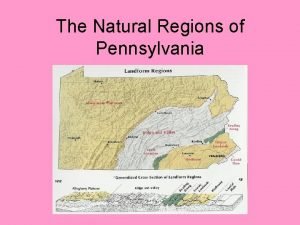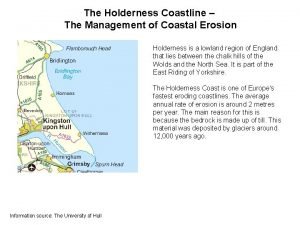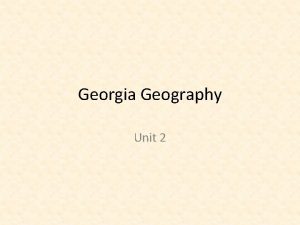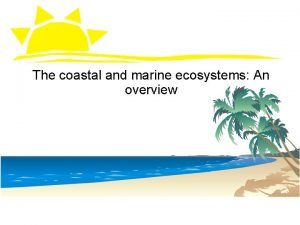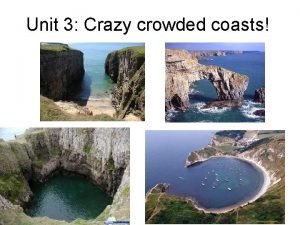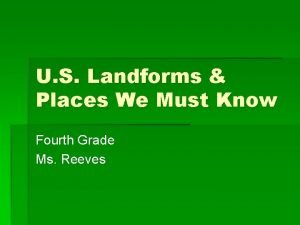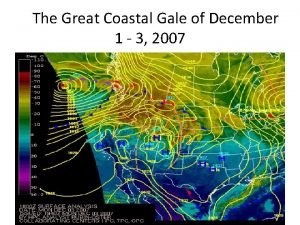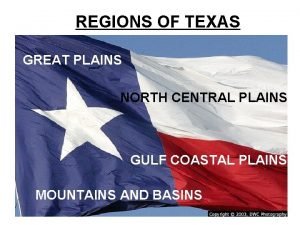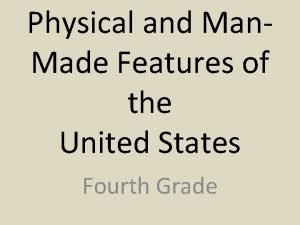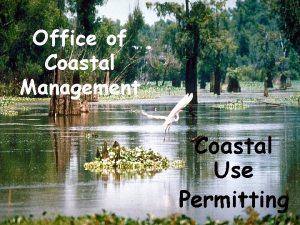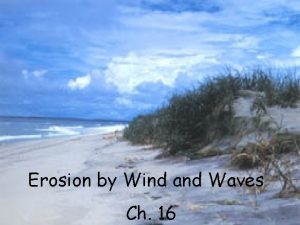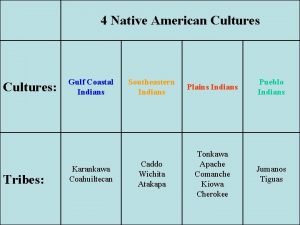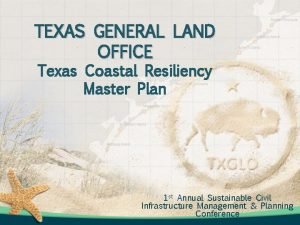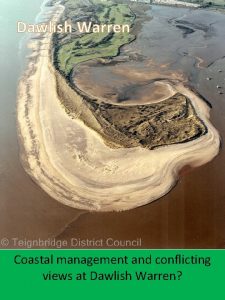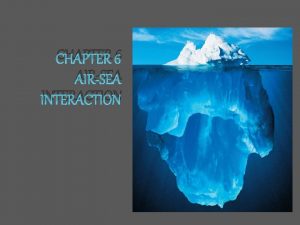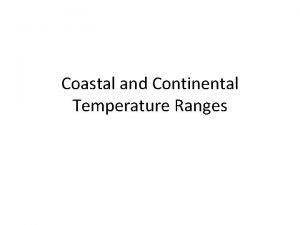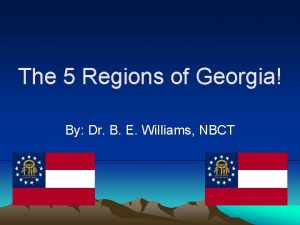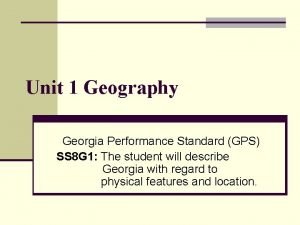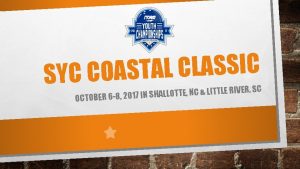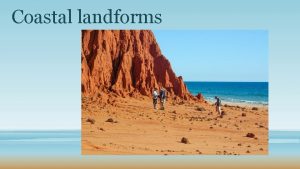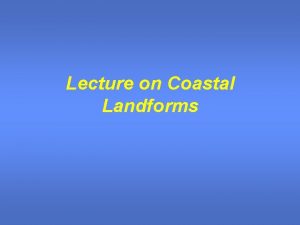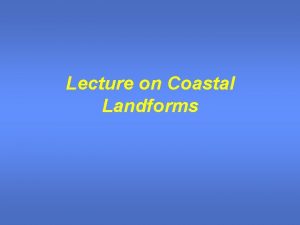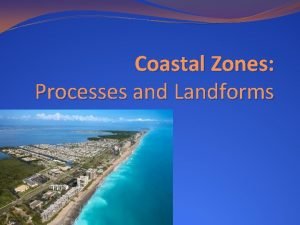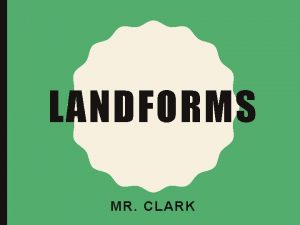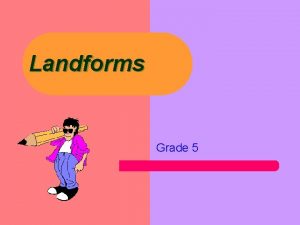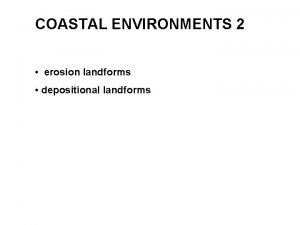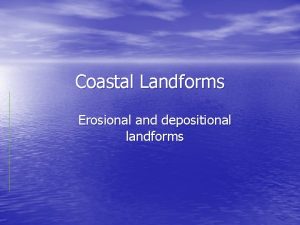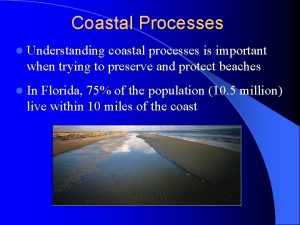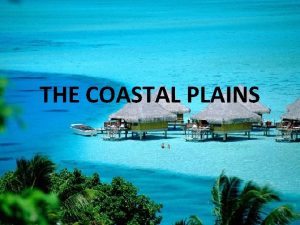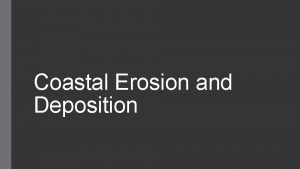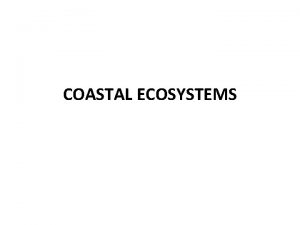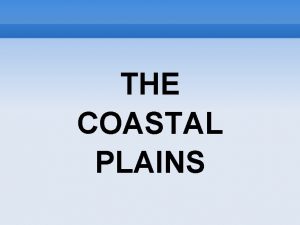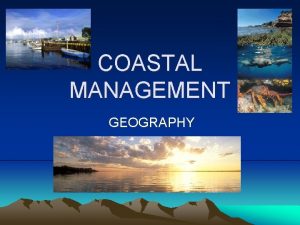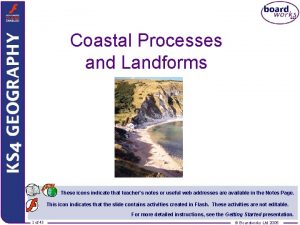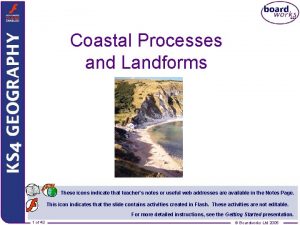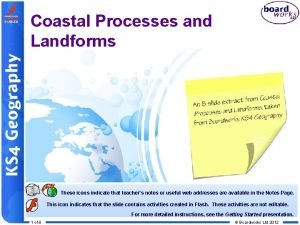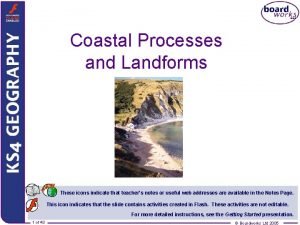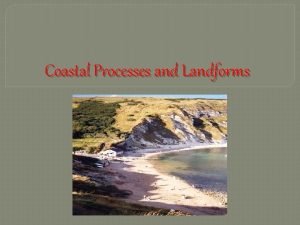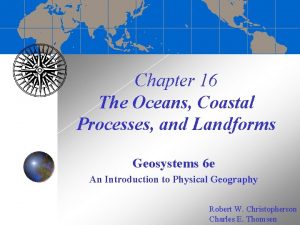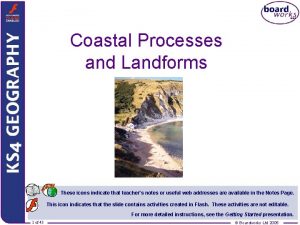Coastal Processes Landforms Ms Carr 5 th year























































































- Slides: 87

Coastal Processes & Landforms Ms Carr 5 th year Geography

Learning Intention • Understand how coastal processes transform the landscape • Examine the landforms created by these coastal processes • FEEDs for these landforms • Feature • Explanation • Example • Diagram • Identify coastal landforms on OS Maps and in Photographs

Today we will. . . • Recall what we already know about coastal processes. • Examine what influences coastal erosion. • Discuss two types of waves. • Recap on processes of coastal erosion. • Textbook pages 122 -124.

Mind Map. . What I already know. .

Chapter 12: Coastal Processes, Patterns & Associated Landforms, & Human Interaction Waves § Responsible for erosion, transportation and deposition of material along coastlines § Generated by wind passing over the surface of the sea § Fetch is the open area of the sea that a wave travels over § The longer the fetch, the stronger the wind speed, the stronger and greater the waves generated

Factors affecting the rate of coastal erosion - Where the breaking of a wave occurs - Highest energy at moment of collapse If it hits a cliff before or after it breaks it won’t erode as much - Steepness of the wave - Formed nearer coast, steeper & stronger - Rock resistance


Chapter 12: Coastal Processes, Patterns & Associated Landforms, & Human Interaction Types of Waves 1. Constructive waves Deposit more than they erode Carries material in Swash up the shore Most common in summer 2. Destructive waves Erode more than they deposit Steep waves Strong Backwash Most common in winter


Chapter 12: Coastal Processes, Patterns & Associated Landforms, & Human Interaction Wave Refraction § Waves slow down as water becomes shallow. § This change in speed causes the wave to bend and change their direction as they approach the shore, this is called Wave Refraction. § This causes waves to move towards the headland where their erosive force is released. § Erosion is stronger on the headland deposition occurs in the bay.

Change of wave direction Debris

Processes • Erosion • Transportation • Deposition

Chapter 12: Coastal Processes, Patterns & Associated Landforms, & Human Interaction Processes of coastal erosion § § § Hydraulic Action Compression Abrasion/Corrasion Attrition Solution/Corrosion

Erosion • Hydraulic Action; direct force of the waves on the coast. • Abrasion; rock debris is hurled by the waves against the coastline. • Attrition; fragments of stone are rounded and eroded by hitting off each other. • Solution; minerals in certain rocks are dissolved by water. • Air Compression; breaking of rock as a result of being trapped by waves in rocks. • Wave Refraction; bending of waves concentrates erosion at headlands, this then leads to the formation of cliffs, caves, arches and stacks.

Chapter 12: Coastal Processes, Patterns & Associated Landforms, & Human Interaction Longshore drift – a process of coastal transportation The sea transports its load of sand shingle in two main ways: 1. Up the shore in swash 2. Back down the shore in backwash

Transportation • Longshore Drift – Movement of material along the coast – Zig zag path – Swash and Backwash


The movement of material along the coastline in a zig zag manner due to the angle of the approaching waves and the slope of the coastline. Deposition occurs because the swash is more powerful than the backwash. The bending of waves due to a headland causing the waves to lose energy and deposition to occur. Erosion occurs because the backwash is more powerful than the swash ? ? ?

Learning Intention • Recap on coastal processes. • Examine landforms of coastal erosion. • Answer a FEED style question on one landform.

Recap • The return movement of water downshore is called _______. • __________ deposit more than they erode and are most common in summer. • When a wave slows down, bends and changes direction it is called _________. • _________ is the zig-zag movement of material along the coast. • _______ happens when fragments of rock are rounded and eroded by hitting off each other. • When rock breaks as a result of being trapped by waves in rocks, it is called __________.

Landforms of Marine Erosion • Cliffs • Wave-cut Platform • Bay • Headland • • Cave Blowholes Sea Arches Sea Stacks

Chapter 12: Coastal Processes, Patterns & Associated Landforms, & Human Interaction Cliffs § Cliffs are vertical slopes on a coastline § Form as a result of a combination of coastal processes of erosion, such as hydraulic action, compression, abrasion, solution and attrition § Destructive waves attack an area of weakness in rocks § Crack/joint forms § Crack/joints are attacked by hydraulic force of the water and by compression § Notch forms


Chapter 12: Coastal Processes, Patterns & Associated Landforms, & Human Interaction § Notch gets bigger, eventually the rocks above the notch (overhang) are unsupported and collapse to form a cliff § Shattered rock falls into the sea § Sea uses this shattered rock to further erode the cliff through abrasion § Solution also erodes the cliff face § These events continue over time and the cliff face retreats § Wave-cut platforms – surface of rock that remains in front of the retreating cliff § Wave-built terraces – deposited pieces of rock that are deposited below low-tide level


Cliffs • Example; – Cliffs of Moher, Co Clare – Hook Head, Co Wexford OS Map- Textbook page 125

Chapter 12: Coastal Processes, Patterns & Associated Landforms, & Human Interaction Bays and Headlands § Differential erosion – rocks along coastlines are eroded at differing rates depending on whether they are soft or hard § Sections of coastline that are composed of soft rock will erode faster than areas composed of hard, more resistant rock § Stretches that are composed of soft rock will form bays § Harder more resistant rock will take longer to erode and will remain jutting out into the sea as headlands





Bays & Headlands • Example; – Dublin Bay – Wicklow Head • OS Map; Textbook page 126

Chapter 12: Coastal Processes, Patterns & Associated Landforms, & Human Interaction Sea Caves, Sea Arches, Sea Stacks and Sea Stumps § Caves form in an area of weakness on a cliff face or headland § Processes of coastal erosion act on this area of weakness and enlarge it to form caves § Caves are further eroded by abrasion, resulting in them becoming larger § Sea arches form when continued erosion occurs in a sea cave causing it to extend right through the headland § A sea arch may also form when two sea caves form back to back on the opposite sides of a headland


Cave, arch, stack, stump

Chapter 12: Coastal Processes, Patterns & Associated Landforms, & Human Interaction § A sea stack is a rock which is standing out in isolation in the sea away from the coastline § Sea stacks form when erosion continues on a sea arch, widening the sea arch and causing the roof of the sea arch to eventually collapse § When the roof of the sea arch collapses, it leaves the former section of headland isolated or cut away from the main headland/coast. What remains standing out in the sea in isolation is called a sea stack § A sea stump is the eroded remains of a sea stack

Cave, Arch, Stack, Stump • Examples; – Hook Head, Co Wexford – Caves; Ballybunion, Co Kerry – Arch; The Bridges of Ross, Co Clare – Sea Stack; Dun Briste, Co Mayo

Chapter 12: Coastal Processes, Patterns & Associated Landforms, & Human Interaction Blowholes § Blowholes form at areas of weakness, for example, where a hole forms on the surface of a cliff top joins with a roof of a sea cave. They are formed as a result of compression. § Air may become trapped in a sea cave by waves. § Results in a build up of pressure which leads to rock shattering the rocks of the cave roof. § Rock eventually collapses creating a ‘blowhole’. § During stormy weather, sea spray blasts out through the blowhole. § Example; Hook Head, Co Wexford. § Geo: a long narrow inlet that forms when the roof of a cave, that was once connected to a blowhole collapses.



Landforms of Coastal Erosion on OS Maps • Textbook- page 128.

Pairwork Quick Questions • List 5 processes of coastal erosion. • List the 3 main landforms of coastal erosion. • Name an Irish example of each of the above landforms. • What does a sea stack look like on an OS map? • Explain the term ‘differential erosion’. • What is a ‘geo’?




Exam Question; FEED Caves, arches, stacks, stumps and blowholes are features of coastal erosion. Caves: what are they? Type of rock they are formed in Why hard rock? Hydraulic Action (P) Compressed Air (P) Weakness in the roof of the cave Formation of a blowhole Continued erosion on roof and back wall Formation of an arch Weathering and erosion of the roof of arch Creation of a stack Erosion of stack Abrasion (P) of stack – why Creation of a stump

Caves are open hollows usually found near the base of a headland on the cliff face. They tend to form in areas of hard rock along the coastline. Soft rock erodes too quickly for a cave to maintain its shape therefore they tend to form slowly in hard rock and can be deep and large. Caves occur due to the main marine processes of erosion such as hydraulic action (the power and the force of the seas waves pounding the coastline) and Compressed air (where air is trapped between the cliff face and the wave and causes the air to expand. This in turn causes the cracks to enlarge and the coastline to erode). Over time the sea will continue to erode the back wall of the cave and in stormy times cracks in the roof of the cave will be further eroded by solution and compressed air. This creates an area of weakness such as a tunnel or vent in the roof all the way to the surface of the headland. If a vent opens from the roof of the cave to the top of a headland a blowhole is now formed. During times of high tide or storms water will force its way up the vent and spray out on the surface. As this feature is formed the cave continues to erode backwards through the headland. Sometimes one cave will erode the whole way through or sometimes two caves will meet from either side of the headland. As this happens an arch is formed. However, the roof of the arch (with the blowhole) is weakened and continuous erosion will cause the roof to collapse. Once an arch collapse the headland appears smaller and the remaining outer wall is called a stack. However there is an increase of broken rocks and debris in the area and the processes of abrasion (the scraping of the seas load against the coastline) will continue to erode the stack. Over time it is eroded down to a stump. This is an area of rock barely visible over the waves and dangerous for incoming boats. The creation of these features are responsible for the coastline appearing to ‘retreat’ and appear smaller on maps/photographs. E: Examples x 3 D: Diagram (frame, title, details, colour, labels)

Coastal Landforms DEPOSITION

Learning Intention • Examine landforms of coastal deposition. • Review a sample answer on one landform. • Answer a FEED style question on another landform.

Chapter 12: Coastal Processes, Patterns & Associated Landforms, & Human Interaction • Textbook page 129 -132

Deposition § Coastal deposition occurs when waves lose energy and therefore their ability to carry material § Sea deposits load on the coastal area § Constructive waves have an ability to move the load inland § Wave refraction in bays result in wave energy decreasing and this results in deposition occurring § Deposited material may include shingle, sand sediment

Landforms of Marine Deposition • Beach • Storm Beach • Sand Spit • Sand Bar • Lagoon • Tombolo

Chapter 12: Coastal Processes, Patterns & Associated Landforms, & Human Interaction Beach § A beach is an area of sand, shingle or gravel § Beaches are created by the processes of longshore drift, constructive waves and wave refraction, § Located in an area between low tide mark and where the highest storm waves can reach § Constructive waves swash is powerful § Waves move up the sea shore, slow down and their load of sand rocks is deposited § Heavier load of rock and shingle is deposited on the backshore § Finer, lighter material such as sand is deposited on the foreshore § Over time a beach is formed


§A storm beach is made of pebbles and stones §It forms when waves are strong enough to push large rocks and boulders above the high tide mark §A storm beach is usually steeper than a regular beach.

Sand Dunes – Hills of sand – Sand is dried and blown inland – Vegetation can trap the sand – Marram grass is sometimes planted to prevent it blowing further inland – Eg; Curracloe, Co Wexford

• Berms – Ridges, like steps or terraces – Gentle constructive waves push sediment into long low ridges – Mark the junction between foreshore and backshore

Runnels & Ridges Runnels-depressions on the sand on the foreshore Ridges-the gentle rises between the runnels Formed by the action of constructive waves

Cusps Cresent shaped hollows where shingle changes to sand Result of complex wave actions on pebble beaches



• Feature • Explain • Examples • Diagram

Chapter 12: Coastal Processes, Patterns & Associated Landforms, & Human Interaction Sand Spit § A sand spit is a long narrow ridge of deposited sand shingle § It is connected to the coast at one end § Sand spits develop due to longshore drift and deposition § Sand spits form where the process of longshore drift is interrupted § Waves lose energy and slow down § Location of estuary or change in wind direction § Sediment is deposited in sheltered and shallow water § Over time this sediment builds up and becomes visible above the level of the sea


Chapter 12: Coastal Processes, Patterns & Associated Landforms, & Human Interaction § On the seaward side of the sand spit constructive waves deposit fine sediment such as sand form a beach § Over time the sand spit gets wider § As sand spits grow the area of water behind it is often then sheltered by waves and wind § This often leads to the formation of a salt marsh § Wave refraction may occur at the end of a sand spit which results in the sediment being carried around the end of the sand spit to form a recurved spit, this looks like a hook.

• Example; Inch Strand, Dingle, Co Kerry


Pairwork Recap • Beaches are created by the processes of; 1. 2. 3. • Three beach features are; 1. 2. 3. • A sand spit is a _______, ____________of deposited _____ and ______. • Sand spits develop due to ____________and _________.

Chapter 12: Coastal Processes, Patterns & Associated Landforms, & Human Interaction Sand Bar & Lagoon § A sand bar forms when a sand spit extends across a bay § Sand bars will eventually seal off an area of coastline § The water directly behind the sand bar will then be called a lagoon


Two Types of Sand Bar Offshore Bar § Located away from the coastline § Parallel to the coastline § Generally only exposed at times of low tide § Breaking waves deposit sand on the offshore bar § Size of the offshore bar increases over time § May eventually block or close off the bay creating a lagoon Baymouth bar § Sand spit extends from one side of a landmass across a bay and reaches the other landmass § Blocks/closes off the bay § Example § Our Lady’s Island, Co. Wexford.



Classwork • Quick Questions –Page 132


Tombolo § Tombolos are formed due to wave refraction and longshore drift § Result from a sand spit extending out to an island connecting the island to the mainland § Waves approach the island, wave refraction occurs § Sediment is deposited § Results in the spit connecting the island to the mainland – a tombolo is formed


Tombolo • Example; – Howth, Co Dublin- Sutton is built on the tombolo.

Coastal Landforms on OS Maps • Textbook page 133

Exam Questions Coastal Processes, Patterns & Landforms







 Erosional coastal landforms
Erosional coastal landforms The climate in the coastal plains region
The climate in the coastal plains region Caves arches stacks and stumps diagram
Caves arches stacks and stumps diagram Marine terrace geology
Marine terrace geology Submergent and emergent coastlines
Submergent and emergent coastlines Glacial processes and landforms
Glacial processes and landforms Concurrent processes are processes that
Concurrent processes are processes that Yr6 leavers poem
Yr6 leavers poem Barry denby
Barry denby Allen carr seminar wien
Allen carr seminar wien Simon thomas carr college
Simon thomas carr college Wilhelm wundt estruturalismo
Wilhelm wundt estruturalismo Indice de carr formula
Indice de carr formula Alexis carr
Alexis carr Bernard carr
Bernard carr Baker vs carr summary
Baker vs carr summary Dr sue carr
Dr sue carr Kirsten carr
Kirsten carr Constructive wave
Constructive wave Eduard einstein schizophrenia
Eduard einstein schizophrenia Baker v carr ruling
Baker v carr ruling Emily carr course selection
Emily carr course selection Baker vs carr summary
Baker vs carr summary Diaglyc 30
Diaglyc 30 Nicholas carr
Nicholas carr Emily carr secondary school library
Emily carr secondary school library Albert z. carr
Albert z. carr Carlo carr
Carlo carr Reagen carr price adalah
Reagen carr price adalah Nicholas carr
Nicholas carr Cultural humility ted talk
Cultural humility ted talk Mc master carr
Mc master carr Scorned as timber beloved of the sky
Scorned as timber beloved of the sky Coastal protection
Coastal protection Texas regions map
Texas regions map Coastal protection
Coastal protection Coastal
Coastal Atlantic coastal plain facts
Atlantic coastal plain facts Coastal environmental systems
Coastal environmental systems Coastal region of texas
Coastal region of texas The advantage of tourism
The advantage of tourism Coastal landscapes in the uk
Coastal landscapes in the uk Coastal deposition
Coastal deposition Dutch coastal rowing
Dutch coastal rowing Uri coastal fellowship
Uri coastal fellowship Coastal sand plains texas
Coastal sand plains texas Longshore drift
Longshore drift Swanage case study
Swanage case study Northwest coastal and plateau tribes
Northwest coastal and plateau tribes Oregon coastal birds
Oregon coastal birds Gulf coastal plain region
Gulf coastal plain region Dahlonega gold rush definition
Dahlonega gold rush definition Basin and range location
Basin and range location Coastal transect
Coastal transect Utkal coast
Utkal coast Coastal environmental systems
Coastal environmental systems Gulf coastal plains
Gulf coastal plains Atlantic coastal plain in pennsylvania
Atlantic coastal plain in pennsylvania Cliff regrading and drainage
Cliff regrading and drainage Coastal plains ga to columbus georgia gps
Coastal plains ga to columbus georgia gps Coastal alabama dual enrollment
Coastal alabama dual enrollment Primary coast
Primary coast Coastal protection
Coastal protection Coastal kung fu
Coastal kung fu Continental divide
Continental divide Coastal carolina student count
Coastal carolina student count Great coastal gale of 2007
Great coastal gale of 2007 California coastal commission jurisdiction map
California coastal commission jurisdiction map North central plains location
North central plains location Is philadelphia man made or natural
Is philadelphia man made or natural Louisiana coastal use permit
Louisiana coastal use permit Coastal region south africa
Coastal region south africa Longshore current
Longshore current Stcw master 500gt
Stcw master 500gt Gulf culture tribes
Gulf culture tribes Appalachian ridge and valley region of new jersey
Appalachian ridge and valley region of new jersey Texas glo gis
Texas glo gis Bipolar analysis of coastal defences
Bipolar analysis of coastal defences Coastal air
Coastal air Coastal and continental temperature ranges
Coastal and continental temperature ranges The 5 regions of georgia
The 5 regions of georgia What are the 5 regions of georgia
What are the 5 regions of georgia Coastal plains ga to columbus georgia gps
Coastal plains ga to columbus georgia gps Attrition erosion
Attrition erosion Natural resources in the plains
Natural resources in the plains Coastal
Coastal Ocean tides observed at coastal locations
Ocean tides observed at coastal locations Syc coastal classic
Syc coastal classic
